![]()
![]()
![]()
Use LEFT and RIGHT arrow keys to navigate between flashcards;
Use UP and DOWN arrow keys to flip the card;
H to show hint;
A reads text to speech;
180 Cards in this Set
- Front
- Back
|
poem one, ozymandias |
ok |
|
|
about the poet |
the poet, percy shelley 1792 born romantic poet came from a very wealthy family comfortable life, went to eaton and oxford expelled from university for writing in favour of atheism age of 16 ran away and got married and then left his wife for a girl named mary drowned at sea whilst sailing to italy at age of 29 not very successful during his lifetime as a writer deeply political person, did not believe in war and only non violent protests |
|
|
context of king george the third |
he wrote this on the rein of king george the third king george the third wa involved in large number of military conflictts around the world shelley hated that oppressive monarchical government, felt a revolution was needed kg is often thought as inspiration of this poem |
|
|
romanticism, |
second generation of romantics needed to set themselves apart, they looked to foreign lands to distinguish themselves often opposed politics, they used rich language which was full of metaphors and classical allusions |
|
|
second context |
ramesees the second, crucial thing is he was a ruler who led many battles to protect egypt and extend its border, very similar to kg the third. deliberate use of this character in my opinion. |
|
|
what are the themes
|
power, those with power are deluded in their belief that their power is supreme and invincible. the idea that those with power think they are all powerful, their power will never go away, the tightened power of leaders does not last but art DOES last. critique of christianity and belief in general. |
|
|
structure and form |
sonnet, about love usually, reflects how ozymandias and the arrogant rulers he reflects how they're in love with themselves. abab in the first 4 lines of the poem is evidence of the shakespearean sonnet then the rhyme scheme changes to cdcd, then efef, then gg. all power ultamitely gives way to new power, nothing remains forever, not even the structure of the poem. |
|
|
language |
ozymandias, broken down, ozy ,greek to breath mandias, to rule. even title suggests power and control |
|
|
i met a traveller |
shelley using the poem to criticise king george the third, he has to distance himself from the poem. thinly veiled attack, not openly criticising the british monarchy. |
|
|
sunk shattered frown wrinkled sneer |
this plethora of deeply negative language is used to make it very clear the poem is an attack and not a prasing up of the powerful |
|
|
cold command |
the alliterative repetition of the sound c reflects the harsh nature of ozymandias |
|
|
king of kings |
religious reference |
|
|
boundless and bare |
alliteration is used to emphasise the emptiness |
|
|
the lone and level sands stretch far away |
the sand outlives the stature, the desert outlives it. nature outlives him |
|
|
where is the irony |
deliberately contrasts what is expected, ozymandias expected to live forever. theme of greatness of art, whilst the rein and majesty of the king does not last, the artists skills in capturing the arrogant sneer is still visible. those looking at it can see the artist within it mocked alternative interpretation, can mean to create and make, or could mean the artist was mocking him, ridiculing him, seems that the artist i syterically attacking his subject. shelley is using the poem to attack king george the third, has to remove himself from the poem |
|
|
how does the poem immediately have a religious undertone |
ozymandias, from the book of exodus |
|
|
king of kings |
title given to jesus, or lord of lords. thinks of himself as god like the desert setting reminds people of the setting for the temptation of the jesus which took place in the desert |
|
|
the new poem, london |
|
|
|
backround of the poem |
in 1789, the french revolution happened some english radicals such as william blake hailed it as a glorious new beginning, and an end to tyranny, more conservative thinkers saw he whole thing as a grosser front to everything good about european civilisation. in addition, the revolution contributed to the growth of radical political groups across england, this fact worried the authorities they were so worried, they started to crack down on things like freedom of the press this repression only increased as things got worse in france the revolution which had started out so promising, quickly deteriorated into a mess of bloodshed, mass executions and power struggles |
|
|
how was william blake affected by this |
he was so affected by these events and how people in england responded he decided to write some poetry. |
|
|
london |
the poem is a very dark poem the poem is about dirt filth disease and plague prostitution and everything that blake felt was wrong about the city |
|
|
london and the structure |
london is written in iambic tetrameter he also uses alternate rhyme, major theme is expressed. social life in london is constricted, confined, and repressed by authority, linked to words such as charterd ,manacles, ban, alternate rhyme is used to suggest that what the speaker sees around him is cyclical and repetitive, and the evils of london will continue to persist in addition to that, william blake uses regular stanzas, again its probably linked to the idea that the evils of london will continue as long as he lives there, its a regular pattern, when he wanders through the chartered street, as if he does that all of the time, confined to do that enjambement, allows the speakers thoughts to flow, also builds up anger, how he is frustrated about how life is |
|
|
stanza 1 |
begins with personal pronoun , I. the poem is autobiographical, detailing what william blake sees about life in london |
|
|
i wander through the charterd streets, near where the chartered thames does flow |
repetition of chartered, this idea suggests even the thames is controlled by government peoples lives are controlled by the government |
|
|
and marks in every face i meet marks of weakness, marks of woe |
marks in every face, metaphore weakness woe alliteration negative emotions highlighting how ppl feel how ppl are so controlled by government and authority, so refined, they are worried and feel anguish about the lives they live |
|
|
in every cry of every man, in every infants cry of fear, in every voice, in every ban, the mind forged manacles i hear |
emotive language
repition of cry infants particularly emotive, because natural the reader will feel sympathy for children that are crying fear emotive, hey are scared of their life ban the rules and regulations that've been put in place by authorities manacles, A RESTRAINT mind forged manacles i hear metaphor to emphasise how even their thoughts have restraints repetition of the word every suggests that nobody is safe, nobody is free of repression |
|
|
how the chimney sweepers cry, every blacking church appalls, |
literal, they ended up black because of the sutt every blacking church appalls , metaphore the idea that they have lost their innocent, lost their childhood, close to the death, black has connotations of death contrasting ideas the church were in charge of chimney sweepers, church appals, church appalled by cries by sense of shock, emotive word appalls almost speaks for reader or listeners, shocked church allowed it |
|
|
the hapless soldiers sigh |
hapless, unfortunate, unable to do anything sigh runs down palace walls metaphor, a symbol for the government, palace here is a symbol of control and authority, metaphor, royalty has blood on their hands hapless emotive word, soldier is helpless to do anything about whats bothering him except to sigh in blood soldier exhales an inaffectual hapless gesture, so powerless in this situation. and so the expression of both is discontent and powerless, the palace is marked by the bloodshed that the soldier was forced to carry out this image reminds us of the manacles that were spoken of earlier, these restrictions are everywhere, 2 examples, suffering kids, and the soldier who was a tool of the governement and a tool of the royal family |
|
|
but most through midnight streets i hear, how the young harlots curse bless the new born infants tear and blights with plagues and the marriage hearse |
idea that the prostitute is foul mouthed, metaphor, children are being brought into a corrupt dirty world of cursing, harlots and blasting the same harlots curse that blasts the baby ears also blights with plagues and the marriage hearse blights and plagues similar, refer to disease, in this instance we can assume its infertility or bareness, brought about by the plagues we assume females are carrying blights, is a verb tarnishes or destroys, harlots curse happened because of her terrible life experience much like the soldiers sigh, and it totally ruins the marriage hearse marriage hearse , oxymoron we associate marriage with union, hearse represents death marriage is a hearse because unmarried harlots are running around , there are babies that have no mothers, marriage has been plagued figuratively and literally |
|
|
an extract from the prelude poem |
jj |
|
|
who was william woldsworth |
in his early life, he had fatherly problems, and his grandparents from his mother's side, they hated him in his early teens, his siblings and him were split apart and sent to live with different relatives for 9 years, which is when he saw his beloved sister during those 9 years, he lived with the so hated uncle and grandparents the effect of living with them was he embraced nature to get away from it all exploring nature and the countryside to get away from the family that he had left |
|
|
what does this poem ultimately teach you |
nature could teach you things about life and philosophy |
|
|
how did william woodsworth feel about violence |
he was an early supporter of the french illusion, and was disillusioned with violence |
|
|
this poem is an epic poem, what does that mean |
that there is one main heroic character |
|
|
what are the themes in this poem |
man, nature, and society |
|
|
one summer evening (led by her) I found |
this is supposedly mother nature, this acts like the personification of nature that has been personified with the feminine gender, |
|
|
a little boat tied to a willow tree, within a rocky sove, its usual home |
''its usual home''- this is all familar to him |
|
|
'' it was an act of stealth and troubled pleasure'' |
this is arrogance, looking back on it from adult perspective he sees his nievity, he sees it was morally wrong, it has connotations of sneaky and sly. links man to being selfish , taking what he wants |
|
|
why is enjambement used here |
enjambemnt is used to suggest on overpowering urge to communicate, the innability to stop and order your thoughts into a coherent structure |
|
|
Leaving behind her still, on either side small circles glittering idly in the moon |
'sparkling' fantastic moments constant use of 'L' creates an atmosphere with great tranquility ''glittering'' the 'ing' pushes it to present tense and is used because it is the climax of positivity |
|
|
why is the positivity here used |
because it will lead to a much greater contrast later when things turn sinister |
|
|
''proud of his skill, to reach a chosen point ..., i fixed my view upon the summit of a craggy ridge'' |
''proud'' pride he feels will ultimately be washed away, and he will be humbled by nature ''chosen point'' arrogance, he willl be completely in control, he thinks he is completely dominant |
|
|
''utmost boundary' |
man again thinking they know everything |
|
|
''elfin pinnace, lustily'' |
this is a mythical quality, he exaggerates this moment in his arrogance |
|
|
''went heaving through the water like a swan; when, from behind that craggy steep till then'' |
''when'' is the volta' 'till then'' inheitens the suspense |
|
|
''a huge peak, black and huge.. upreared its head'' |
this is deliberate, all his ambitious expressive vocabulary deserts him this is the revelation of the subject, the verb is delayed |
|
|
'' for so it seemed, with purpose of its own, and measured motion like a living thing'' |
for so it seemed- disclaimer ''its'' poet loses his power, their is a shift in pronoun to represent his shock and horror, he now feels vastly different |
|
|
''back to the covert of the willow tree'' |
back to where he stole it, in which he is unable to articulate it'' |
|
|
''there hung a darkness, call it solitude.. no familar shapes.. no pleasant images of trees... no colours of green fields'' |
'call it solitude'' this is vague, shows he is struggling to descrive, it is different from the beginning, this shows his transition the constant repeat of ''no'' shows how very aware the poet is, and shows he realises their is so much he does not know, his pride has vanished, and only able to explain things with the things he does not know, he is overall unable to define what he knows |
|
|
why is this poem written in blank verse |
this is because of the influence of the poet milton, who at the time, all lengthy poems that were phillisophical were written in blank verse |
|
|
how does the structure help give the message of the poem
|
there are no pauses, it is one long verse, the reader is overwhelmed by the immensity of the poem, and helps the reader empathise with the emotions that the poet was going through |
|
|
My last duchess the poem
|
hhpo |
|
|
who was Robert Browning
|
he did not enjoy school, he was home schooled, his father's library had 6,000 books, fluent in 14 languages he had a secret marriage, but the marriage was kept secret because her father was domineering and controlling lived in Italy, in 1838 he lived through the Victorian era published in 1842- |
|
|
what is the context of the poem
|
suffrage movement was growing/ battle of equality his ideas were to give the message for gender and discrimination |
|
|
what was it like for women
|
women were irrational women could not vote women could not testify many female writers published their works anonymously in order to boost book sales.. Browning wrote to explore his opinions on this topic, |
|
|
what is this poem ultimately suggesting about women
|
its possible to see the poem as a criticism of attitudes to women and their effort to suppress female sexuality, the dukes obsession with fixing his wife links to Victorian society expecting women to be perfect
|
|
|
what are the major themes of the poem?
|
POWER there are 2 type of distinct power in the poem political power, demonstrated through the lines I gave commands.. the reader is left wondering who the commands were given to 2) domestic power- the duke wishes to assert his power in his polical sphere over his wife.. 3) the role of women, gender discrimination, sexism |
|
|
'her looks went everywhere'- we first have to establish if the duke has any cause for concern with his last wife
|
the wife is presented as weak and undeserving of her own wife the duke is controlling, insane |
|
|
use of language to present the duke as a madman, how is he presented
|
///////
|
|
|
that's my last duchess painted on the wall
|
the personal pronoun 'my' which is repeated in the poem displays the Duke as possessive, it is all about him, self obsessed, believes his wife belongs to him, one of his objects |
|
|
I said 'Fra pandolfs'
|
fra pandolf- they are not real artists. used to show how vein he is, he wants to show off, be vein. 'fra' means brother, the title suggests the artist was a monk, or a religious figure, suggests picture was painted was a monk this shows the artist was not involved at all, he did not even flirt with the duchess, so when the duke suggests he flirted with her to provoke the look, the duke is displayed as paranoid. |
|
|
'sir, 'twas not her husband's presence only'
|
the manner in which the duke speaks to envoy with pronound like sir and you are formal terms of address, they might seem quite polite. they clarify his superiority, the more friendly terms of thou and thee might have been used if they were on more equal terms. the duke is keen to point out he is socially superior which portrays him as condescending |
|
|
'my gift of a nine hundred years old name'
|
The duke is proud, he feels the duchess was lucky to have the name, she should be delighted and proud.
|
|
|
(which I have not)
|
here he is presented as a liar, he does not have the skill in speech. he could not talk to his wife about it, speaking in iambic pentameter, he is pretending he could not talk to her, he is DISINGENUOUS |
|
|
the duke is seen as self obsessed, which Is seen with the repetition of the pronoun 'I'
|
''I CHOOSE.... I PASSED HER... I GAVE COMMANDS'' this man is self obsessed, it is all about him |
|
|
will't please you sit will't please you rise |
these are demands, he frames them as questions, this Is a social superior demanding something from an inferior, he is a controlling character so the envoy would have to look up to the duke whilst he speaks, this is a symbol of power |
|
|
what Is this poem
|
a dramatic monologue |
|
|
the metaphor, piece of art work taught at the end of the poem ''Neptune, though, taming a sea-horse, thought a rarity; which claus of Innsbruck cast in bronze for me!' |
Neptune was god of the sea, big strong masculine domineering God, in the sea, the duke sees himself as a reflection of this, he is here to domineer and control women, to tame them, the male dominated society of Victorian England, the mans job is to dominated the women, to tame her as if she is wild |
|
|
another metaphor, the painting itself ''the curtain I have drawn for you'' |
only he can pull back, he gets to control the smiles of his wife, what he wanted in life, clever bit of metaphor and symbolism, very clever, it is ambiguous, did he have his wife killed |
|
|
what is the form of the poem
|
the speaker is not the poet, the listener is silent throughout we are listening to a one way converstion, allows us to identify the speakers character, this poem is written in iambic pentameter, the rhyme scheme is controlled, whole poem in rhyming couplets, this tight control of rhyme scheme and the amount of syllables per line reflects the tight control of the duke, he is an extremely controlling character. the form reflects the character of the duke |
|
|
the poem contains enjambement
|
the technique where sentances run over the lines, the poem is supposed to be real speech, it wouldn't be as convincing if the sentances ended on each line and the couplets too , it would sound mechanical the alternative alternation is the enjambement that the duke does not have complete control, despite he does everything to control others which is displayed in the tight rhyming couplets, he himself is quite uncontrolled and wild in his anger, the fact is he cannot control himelf seen through the enjambement, the image that is created is this crazy man that cannot control his outbursts. this poem is one long verse, this is important and significant because it reflects that the duke does not stop to order his thoughts and words, he spouts out his thoughts in a sort of stream of consciousness style |
|
|
what is the effect when we read the poem aloud with no major breaks or pauses
|
there are no stanza changes, we r overwhelmed by the immensity of the poem, almost breathless, this overwhelming aspect itself reflects how the duke is an overwhelming character . the form of the poem reflects the duke
|
|
|
ambiguous phrases 'as if she were alive' |
the painting is life like, almost photographic of his former wife or, she is actually dead |
|
|
''I gave commands' |
cold short brutal line. ambiguous, what commands did he give, did he send her to death, |
|
|
''her looks went everywhere' |
|
|
|
what is this poem
|
power, complete control, he uses the power to have his wife killed, we can interpret the poem to be about male power, men have complete control a portrayal of the duke's weakness her looks went everywhere we see his paranoiance, the dialogue is a sprawling piece, he is careless presents the duke in someways as being weak, because brownings poem can be read that Victorian mean are weakened by their power over women, why is It so important to him that they have power over their wives. |
|
|
The charge of the light brigade
|
slso |
|
|
what do you know about the poet Alfred lord Tennyson?
|
Victorian poet his engagement 2 Emily was at one point forbidden due to his poverty, he forbade it, he was too poor important- there is an underlying sense of criticism of the upper class that we see, heavily influenced by that 1850- rich celebrity poet, wrote the charge of the light brigade in 1855 during the poet laurette |
|
|
historical context of Crimean war
|
brief explanation, 1852-1856 essentially Russia tried to take over Romania Britain was involved out of fear, that it would influence our trade route it was an unpopular war, why was UK involved highest levels of command mistakes, frustrated the british public the light brigade was made up of lightly armoured troops on horseback, they went to attack Russia to protect guns that were potentially being stolen the cavalry were higher social status soldiers (most expensive to get into), had to buy your own horse/equipment, they were disrespected by the working class soldiers there was a mixup between the leaders, the light brigades went to the wrong place down through the valley, and it was the wrong thing to do, they were being shot. rather then retreating, they were committed to it, and were torn to pieces by the enemy's gunfire all 600 or so of them charged in, those who were still alive at the end of the valley died it was a tragic futile mission |
|
|
hideous blunder
|
the futile mission, a stupid mission, misunderstanding, Tennyson got this word BLUNDER stuck in his head |
|
|
What is the form of this poem?
|
This poem is a BALLAD
|
|
|
what is a ballad and when Is it usually used? |
used so we never forget historic form of poetry often used to be song, contains a refrain, line repeated regulary refrain is ''600'' at the end of each verse used for important stories associated wit history, the fact Tennyson uses the form BALLAD suggests element of folk law to charge of the light brigade, and it is an awe inspiring act of bravery that we should never forget how brave these soldiers were and therefore balld makes sense |
|
|
what is another reason a ballad is used? |
so we never forget the stupidity of the aristocratic leadership and the blunder that ultimately caused the whole thing to take place, it is a cautionary tale
|
|
|
how does Tennyson use DATYLIC DIMETER
|
why Is it used?- Tennyson uses dactylic dimeter here because... forward the light brigade was there a man dismayed not though the soldier knew someone had blundered theirs not to make reply theirs not to reason why theirs but to do and die positive interpretation- awe of bravery, use of dactylic dimeter, he wnts us to fully appreciate bravery of soldiers, to feel as if we were there so we can empathise and understand and appreciate their bravery to the highest level. the beat the dactylic dimeter creates mirrors the galloping hooves of the horses, there is a sense the poem sounds like the battle. the use of dactylic dimeter echoes the hoof beats of the horses, add energy and pace, the reader can empathise |
|
|
how does he use falling rhythm / WHY
|
argued to show the falling soldiers
|
|
|
negative use of dactylic dimeter, |
there is a satirical use of dactylic dimeter criticism of upper class, he uses humour to attack the injustice in society and he does it discretely. Tennyson is criticising and mocking the stupidity of the leadership choices |
|
|
there is one line that does NOT conform to dactylic dimeter
|
''someone had / blundered '' someone had blundered is clearly an important line, we already know that it was the word blundered that was taken out of the original news report, Tennyson had it stuck in his head he is emphasising the word, and criticising the leadership error that led to this practically suicidal mission, he is drawing our attention to this deliberate critique the word blunder means stupid mistake, by deliberately breaking the rules of his chosen poem structure, he breaks this rule so we can see what he is criticising, as dictated as his role of poet laurette. |
|
|
what else can you say about the length of this line ''someone had blundered''
|
this fourth line is shorter and mirrors the dramatic stop and shortening of the soldiers lives who are about to die |
|
|
language of the poem '' though I walk through the valley of the shadow of death'' |
by putting it in the first verse, Tennyson is trying to immediately bring in biblical imagery |
|
|
what does the biblical reference do, why does he use it
|
the bibilical imagery is literally a reference to psalm 23 and the story of david and goliath which both show an underdog taking on a supreme power, this underlines the bravery of the soldiers |
|
|
''theirs not... theirs not....theirs not''
|
Victorian England there was an order of value and obedience to hierarchy and we see this in the soldiers, charging into gunfire, it is not their job to question it, they have to do it it Is not their choice no sense of freedom in the armed forces, should not take orders from someone just because they are richer |
|
|
'' all the world wondered'
|
ambiguous word in the positive analysis, we can interpret this word to mean to admire, amazed, awestruck the secondary meaning is to question,? with this interpretation in mind, we can see the line to mean the whole world is questioning how such a stupid mistake can be made it is great how his words are ambiguous it also carries in it, the sound of the poets pride for men in 'won' alongside the awareness of the pointlessness of their death 'ered' |
|
|
what else can we say about the word wondered
|
'thundered... shattered... sundered.. blundered'' All of these words are used the use of the 'ered' sound, the finetic similarity to the word er, ie to make an error, throughout the poem there is a suttle reminder of an error
|
|
|
expore by wilfrend owen
|
ok |
|
|
who was Wilfred owen as a poet
|
joined the army in 1915, originally pursued a career in the church, avid fan of the poet john keats, he didn't decide to persue his religious career,he gave up on the church, there was hypocrisy in the church, they did not look after people the way that they should have
|
|
|
the historical context ww1 poetry
|
before owen, war poetry focused on patriotic values which praised the glorified battle (charge of the light brigade) the british attitudes to war, they had not experienced a major war in over a 100 years, war was seen as something brave people did, something exciting. owen is very keen to dispel his idea and expose the reality of war he did not believe the glory of war he believed war was pointless, this is the reoccurring theme throughout his poetry that war is FUTILE |
|
|
what does exposure show
|
the war is between soldiers and weather conditions, explore the idea as NATURE as the enemy, he uses language structure and form to help the reader empathie waiting long day for action that never happened, getting slowly killed by the harsh weather conditions, their suffering is pointless and futile |
|
|
title exposure
|
refers to the exposure of the truth for the british public of the reality of war, war is not glorious, it is awful, he is exposing it |
|
|
structure of poem
|
he wanrs readers to understand the intensity of waiting for battle, and the anti climatic atmosphere when nothing happens. it would go on for years and years, soldiers lived on adrenallin, leads to shell shock. to help the reader to empathise with this, he structures each stanza in the same way |
|
|
how does he structure each stanza |
'' OUR BRAINS ACHE IN THE MERCILESS ICED EAST WINDS THAT KNIVE US..'' HE STARTS IT WITH THIS BECAUSE IT IS A BLUNT AND POWER FUL SENTANCE MERCILESS AND KNIVE ARE EMOTIVE |
|
|
''WEARING.. LOW DROOPING... CONFUSED.. WORRIED.. NERVOUS''
|
after the blunt sentence, highly expressive vocab is used to heiten the tension, this is a climactic moment of energy
|
|
|
what happens after the dramatic vocabulary |
crucially after heitening the tension, each stanza ends with an anti climactic sentence 'but nothing happens'- ends up being nothing |
|
|
what do the 8 lines represent ' |
|
|
|
what is the rhyme scheme |
ABBAC... this reflects the building momentum and anticipation of battle which is never realised. it backs up the structure, it stays this way throughout the entire poem, there is so much that takes place, the rhyme scheme stays w its repetitive nature reflecting the repetitive and futile nature the soldiers are in. just as the poem stays the same, so does the situation for the soldiers |
|
|
why does the poet employ pararhyme
|
gives the poem a permanent sense of being on edge, incomplete, not quite right the soldiers are ultimately denied the satisfaction that would come with full rhyme the rhyme is forced, imperfect. perfection and closure is denied in war like it is in ryhme |
|
|
ending sentence of each stanza |
is it that we are dying? we turn our back to our dying For love of God is dying they are responding to eachother final line is deliberately ambiguous, knowing owen had turned his back on religion, is he saying something religious here, or about God. it suggests people are losing faith when exposed to horrors of war, they ultimately question how can there be a God in a world so full of evil |
|
|
'dying'
|
soldiers and Christ like characters, they sacrificially die to save others , and of course this is the ideology behind war. |
|
|
where is the personification used in this poem and how does it highlight how nature is a threat |
'mad gusts' 'dawn massing in the east her melancholy army' 'air that shudders with black ice' 'pale flakes with fingering stealth faces' personification- constantly used |
|
|
why does he use so much personification used so much |
he uses military imagery to describe the rain.. |
|
|
where is sibilance used |
the sybillance is like the sound of bullets passing over head... or shivering sounds sybillance is a sinister sound, it reminds us of the hissing of snakes, it really creates this negative atmosphere that reminds us of the constant negative atmosphere the soldiers are in |
|
|
why is there a use of a caesura
|
''slowly our ghosts drag home: glimpsing the sunk fires'' the caesura is used in this stanza to create a division to reflect the division caused by home and the present setting for the soldiers in a freezing cold trench. |
|
|
''But nothing happens'' |
this is depressing and bleak. but nothing happens, structurally the poem ends as it began with the refrain ''but nothing happens'' this repetition from going back to the start creates a cyclical structure, this highlights the futility of the war and the fact that nothing has been achieved they are just slowly dying
|
|
|
storm on the island, SEAMUS HEANEY
|
Northern irish pot playwright and translator, early potry focused on rural life and identity |
|
|
structure of this poem, the power of nature
|
the power of nature one long stanza made up of long and complex sentances lack of stanza breaks and breathing space reflects the overwhelming situation, it is a non stop speech, no time to stop think and breath, and that Is very much like the danger of this storm. |
|
|
why does the poem contain enjambment
|
'nor are there trees which might prove company when it blows full blast' like the use of one long stanza creates a constant barrage of information, this reflects the constant barrage of the storm on the house. |
|
|
how can we link the overwhelming constant barrage to the power of nature
|
reflected through the structural choices |
|
|
''you know what I mean'' |
this oxymoron reflects how the reader has made sense of the dangerous world in which he lives |
|
|
how is the storm being nothing new to the poet reflected in the rhyme scheme
|
the poet uses a half rhyme [''we are prepared; we build our houses squat, sink walls in rock and roof them with good slate'' lack of control is represented in the lack of rhyme, the poem lacks control. the useof half rhyme ties in with the other usages in the poem; the wild storm refuses to be controlled or organised, the half rhyme is all that is possible amidst the chaos. Heaney knew using full rhyme would have been too perfect, too obvious, too explicit, too different. |
|
|
why does the poem end as it begins with a half rhyming couplet
|
gives the poem the cyclical structure, creating the sense the storm is inescapable and will continue to occur time and time again. |
|
|
how is this dramatic monologue |
one sided view of the whole convo we could say the dramatic monologue form reflects the inbalance between the relationship of the speaker and nature, there is only one dominant voice in that relationship the lack of voice suggests nature is indifferent to what is going on, it doesn't care that it batters the narrators home and fills him with fear |
|
|
how is the poem about conflict in northern island |
'stormont' the parliament houses in Ireland.
|
|
|
why does the poet use the pronoun we?
|
this suggests solidarity, it is inclusive for safety. the language choice suggests opposition and can be seen to represent the group as a catholic group, the most obvi |
|
|
the poem poppies by Jane weir |
the poem explores the emotions of a woman whose son was killed in battle |
|
|
what do you know about the form of this poem |
there is a non chronological form about this poem three days before you left after you'd gone this is where it has led me shift in tense and use of different pronouns |
|
|
why is narrative structure used |
shows the speaker is remembering past events- her memory is switching back and forth, backs to her last memory of him as he leaves the home for the last time, her memories fluctuate. this reflects the different ways in which she grieves |
|
|
what do the first and second personal pronouns convey |
they convey the speaker is directly adressing her son trying to make a connection as if he is still there, trying to keep the connection alive |
|
|
give a few quotes of this poem to analyse in language |
spasms of red paper disrupting a blockade bandaged around my hand reinforcements crimped petals yellow bias |
|
|
which quotes support the poet uses military language |
blockades reinforcements |
|
|
where are the metaphors that have suggested conflict |
disrupting a blockade this is a metaphor suggesting the conflict bandaged around my hand the word bandaged a metaphore that has suggested conflict and violence but also healing |
|
|
where is the language the evokes colour and texture |
crimped petals yellow bias materials : tucks, darts, pleats, hat less sense of texture |
|
|
why does the writer use such metaphores |
whilst the author is trying to remember her son she cannot escape from an implied violent death her son has suffered. there are hints within the spasms of paper red ~+ bandaged = violent death her memories enable her to maintain a connection with her son but she is unable to avoid thinking about his injuries and ultimate death |
|
|
stanza one - detail of colour and texture |
she remembers in detail, is picking out in smaller points memories are vivid, more clear, more immediate through her grief and sense of loss |
|
|
quotes to show the writers use of imagery |
spasms of paper red the red of the poppy would suggest a wound, the look of a poppy suggests a wound. cat hairs on the blazers images of childlike innocence, imagery, released a song bird from its cage shows two things lettting go of son, and letting go of son, letting go of emotions |
|
|
How does the poet use imagery in stanza one to talk about war |

Back (Definition) |
|
|
How does the poet use imagery in stanza one to talk about war |
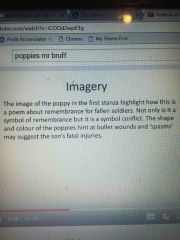
Back (Definition) |
|
|
In the second stanza how does the poet remember her son |
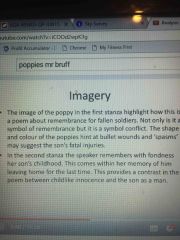
Back (Definition) |
|
|
How does the poet use imagery in stanza one to talk about war |
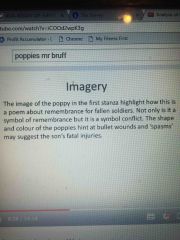
Back (Definition) |
|
|
In the second stanza how does the poet remember her son |
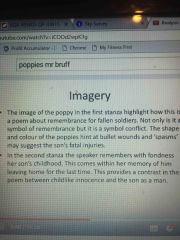
Back (Definition) |
|
|
How does the reader use a metaphore in the last paragraph to symbolise liberty and freedom of the memory of the child |
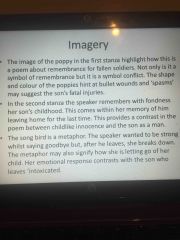
Back (Definition) |
|
|
How does the poet use caesuras show the poet is not strong |
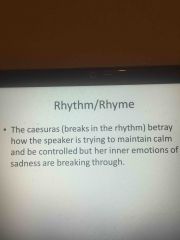
Back (Definition) |
|
|
How does the poet use caesuras show the poet is not strong |
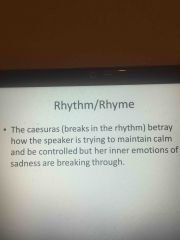
Back (Definition) |
|
|
How does the writer use time throughout the poem |
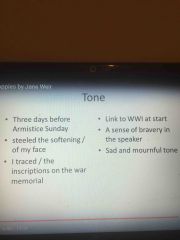
Back (Definition) |
|
|
How does the poet use caesuras show the poet is not strong |
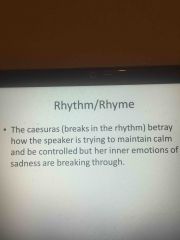
Back (Definition) |
|
|
How does the writer use time throughout the poem |
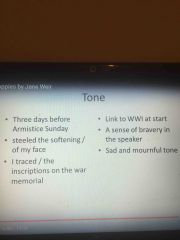
|
|
|
How does the writer use tone ( with more detail ) |
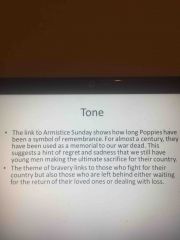
|
|
|
War photographer by Carol ann duffy |
interested in the dilema of being a war photographer |
|
|
what is thr theme of the poem |
the impossibility of presenting war (like bayonet charge) |
|
|
Ted hughes could not find vocabulary to express the horror of war- what is the difference in war photographer |
in war photographer, photo shows war, people are refusing to accept the reality of wars |
|
|
what is the structure of the poem |
tight and c |
|
|
What is the structure of war photographer like |
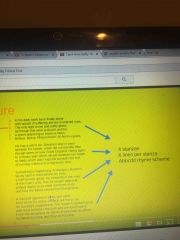
Very similar all the way through Very tightly controlled Interesting because there are alternative interpretations You could say it reflects the wp job who is trying to impose order on the chaos of war, so we can look at it and then forget about it . Suffering in war cannot be forgotten and controlled There is a juxtaposition we have a nearly ordered structure but the theme is something uncontrollable , the two contradict eachother. A contrast is something we see throughout the poem unending message of what we see and think about war and the reality of war which is impossible to understand We could say unchanging structures also show how the war photographers efforts are futile, nothing changes . Trying to make us realise the reality of the horrors of war but everything carries on normal verse after verse like the previous ones- his efforts are futile |
|
|
What is the structure of war photographer like |
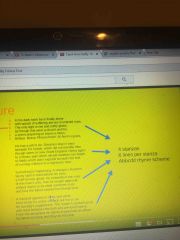
Very similar all the way through Very tightly controlled Interesting because there are alternative interpretations You could say it reflects the wp job who is trying to impose order on the chaos of war, so we can look at it and then forget about it . Suffering in war cannot be forgotten and controlled There is a juxtaposition we have a nearly ordered structure but the theme is something uncontrollable , the two contradict eachother. A contrast is something we see throughout the poem unending message of what we see and think about war and the reality of war which is impossible to understand We could say unchanging structures also show how the war photographers efforts are futile, nothing changes . Trying to make us realise the reality of the horrors of war but everything carries on normal verse after verse like the previous ones- his efforts are futile |
|
|
Rural England is between two full stops, caesura |
Seperated completely Forced to stop Able to separate what they see We would look and be temporarily moved but fail to really grasp true horrors of war |
|
|
What is the structure of war photographer like |
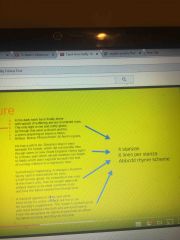
Very similar all the way through Very tightly controlled Interesting because there are alternative interpretations You could say it reflects the wp job who is trying to impose order on the chaos of war, so we can look at it and then forget about it . Suffering in war cannot be forgotten and controlled There is a juxtaposition we have a nearly ordered structure but the theme is something uncontrollable , the two contradict eachother. A contrast is something we see throughout the poem unending message of what we see and think about war and the reality of war which is impossible to understand We could say unchanging structures also show how the war photographers efforts are futile, nothing changes . Trying to make us realise the reality of the horrors of war but everything carries on normal verse after verse like the previous ones- his efforts are futile |
|
|
Rural England is between two full stops, caesura |
Seperated completely Forced to stop Able to separate what they see We would look and be temporarily moved but fail to really grasp true horrors of war |
|
|
'With tears between the bath and pre lunch beers' |
half rhyme- mid line rhyme. Quickens pace , represents speed at which people forget. Overloaded with sensory imagery , then we forget, reflects speed at which people forget the horrors of war |
|
|
What is the structure of war photographer like |
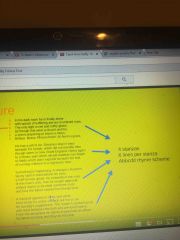
Very similar all the way through Very tightly controlled Interesting because there are alternative interpretations You could say it reflects the wp job who is trying to impose order on the chaos of war, so we can look at it and then forget about it . Suffering in war cannot be forgotten and controlled There is a juxtaposition we have a nearly ordered structure but the theme is something uncontrollable , the two contradict eachother. A contrast is something we see throughout the poem unending message of what we see and think about war and the reality of war which is impossible to understand We could say unchanging structures also show how the war photographers efforts are futile, nothing changes . Trying to make us realise the reality of the horrors of war but everything carries on normal verse after verse like the previous ones- his efforts are futile |
|
|
Rural England is between two full stops, caesura |
Seperated completely Forced to stop Able to separate what they see We would look and be temporarily moved but fail to really grasp true horrors of war |
|
|
'With tears between the bath and pre lunch beers' |
half rhyme- mid line rhyme. Quickens pace , represents speed at which people forget. Overloaded with sensory imagery , then we forget, reflects speed at which people forget the horrors of war |
|
|
How does the poet use a cyclical structure |
It begins with the war photographer coming back from a trip and ends with him going back onto another trip- ends where it starts . It is employed to link to the theme of fate, everything is pre determined and set, no escaping it just going round in a loop. Futility of his job- quick two second glimpse of the photo and carrying on with their ordered a structured lives and forgetting about it . Such a futile endeavour |
|
|
Dark room The lifht is red How do these symbolise things |
Both have very sinister and evil connotations, these greatly comtrast with the religious references in the same verse of mass and church . this could suggest the religious imagery suggests a serious Solemn role to his work . The contrast in the poem , a seeming contradiction, two things that are opposed. Trying to make order of something that is chaotic |
|
|
Dark room The lifht is red How do these symbolise things |
Both have very sinister and evil connotations, these greatly comtrast with the religious references in the same verse of mass and church . this could suggest the religious imagery suggests a serious Solemn role to his work . The contrast in the poem , a seeming contradiction, two things that are opposed. Trying to make order of something that is chaotic |
|
|
The spooks of suffering set out in ordered rows |
The ordered Rows reminds us of wall graves and church rows . Another contrast. |
|
|
Dark room The lifht is red How do these symbolise things |
Both have very sinister and evil connotations, these greatly comtrast with the religious references in the same verse of mass and church . this could suggest the religious imagery suggests a serious Solemn role to his work . The contrast in the poem , a seeming contradiction, two things that are opposed. Trying to make order of something that is chaotic |
|
|
The spooks of suffering set out in ordered rows |
The ordered Rows reminds us of wall graves and church rows . Another contrast. |
|
|
All flesh is grass |
Book of Isaiah The poem in its reference is highlighting the fragility of life. We do not fully acknowledge the fragility of life despite how many people have written about it ( very historic ) hide away from it |
|
|
Dark room The lifht is red How do these symbolise things |
Both have very sinister and evil connotations, these greatly comtrast with the religious references in the same verse of mass and church . this could suggest the religious imagery suggests a serious Solemn role to his work . The contrast in the poem , a seeming contradiction, two things that are opposed. Trying to make order of something that is chaotic |
|
|
The spooks of suffering set out in ordered rows |
The ordered Rows reminds us of wall graves and church rows . Another contrast. |
|
|
All flesh is grass |
Book of Isaiah The poem in its reference is highlighting the fragility of life. We do not fully acknowledge the fragility of life despite how many people have written about it ( very historic ) hide away from it |
|
|
Plosives sounds Belfast. Beirut. Phnom Penh |
quick harsh sounds like gun fire, they break the peace of what went before and give us the quick sounds of gunfire . Caesura forces up to stop and think- criticising how we don't stop and think. Makes us stop and think |
|
|
Dark room The lifht is red How do these symbolise things |
Both have very sinister and evil connotations, these greatly comtrast with the religious references in the same verse of mass and church . this could suggest the religious imagery suggests a serious Solemn role to his work . The contrast in the poem , a seeming contradiction, two things that are opposed. Trying to make order of something that is chaotic |
|
|
The spooks of suffering set out in ordered rows |
The ordered Rows reminds us of wall graves and church rows . Another contrast. |
|
|
All flesh is grass |
Book of Isaiah The poem in its reference is highlighting the fragility of life. We do not fully acknowledge the fragility of life despite how many people have written about it ( very historic ) hide away from it |
|
|
Plosives sounds Belfast. Beirut. Phnom Penh |
quick harsh sounds like gun fire, they break the peace of what went before and give us the quick sounds of gunfire . Caesura forces up to stop and think- criticising how we don't stop and think. Makes us stop and think |
|
|
Half formed ghost |
Amibiguous- half formed like the photo . Half a memory- not fully remembered |
|
|
Dark room The lifht is red How do these symbolise things |
Both have very sinister and evil connotations, these greatly comtrast with the religious references in the same verse of mass and church . this could suggest the religious imagery suggests a serious Solemn role to his work . The contrast in the poem , a seeming contradiction, two things that are opposed. Trying to make order of something that is chaotic |
|
|
The spooks of suffering set out in ordered rows |
The ordered Rows reminds us of wall graves and church rows . Another contrast. |
|
|
All flesh is grass |
Book of Isaiah The poem in its reference is highlighting the fragility of life. We do not fully acknowledge the fragility of life despite how many people have written about it ( very historic ) hide away from it |
|
|
Plosives sounds Belfast. Beirut. Phnom Penh |
quick harsh sounds like gun fire, they break the peace of what went before and give us the quick sounds of gunfire . Caesura forces up to stop and think- criticising how we don't stop and think. Makes us stop and think |
|
|
Half formed ghost |
Amibiguous- half formed like the photo . Half a memory- not fully remembered |
|
|
' And they do not care' |
Who is they? Public? the wider world ? IS it us as the reader of the poem ? The poem is about the futility of being able to try and express the reality of conflict People don't fully engage, they give a fleeting look |

